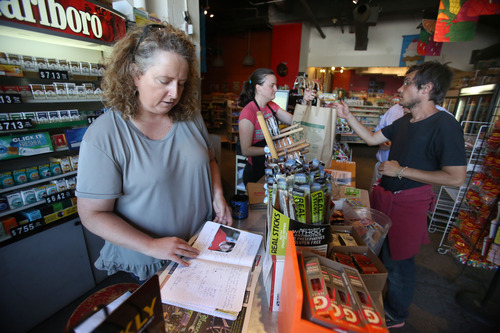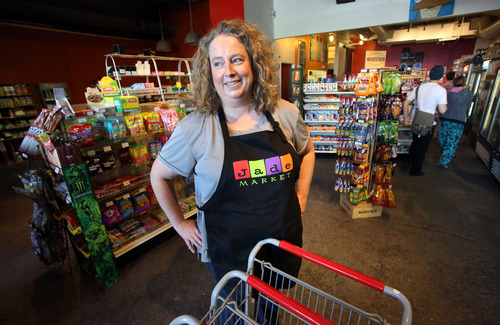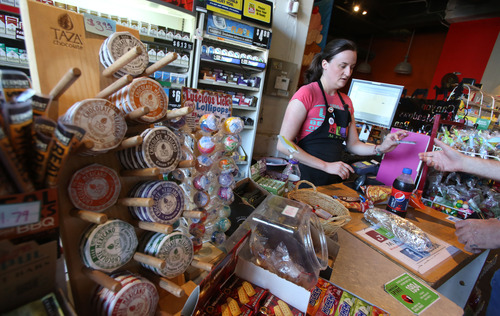This is an archived article that was published on sltrib.com in 2013, and information in the article may be outdated. It is provided only for personal research purposes and may not be reprinted.
The Rio Grande neighborhood surrounding Pioneer Park has the kind of potential that would make it Salt Lake City's hippest urban zone but for one thing: the homeless.
The area seems to be in transition with new housing and restaurants, but it's still one of the city's grittiest places, largely because it's ground zero for the homeless from around the state and region.
Nonetheless, its full-time residents and business owners are attached to Rio Grande because it holds great possibilities and feels more urban than almost anywhere in Utah. Many of its denizens don't want to give up in the face of an unmistakable uptick in social challenges provided by the homeless population, including violence, drug use and property crime.
But Ema Ostarcevic has had enough. She lives in an upscale loft on 200 South between 300 West and 400 West. She's planning to move because her neighborhood is fraught with bedraggled men who use drugs and alcohol, can be menacing and frequently use the area around her building as a restroom.
Police officers on bicycles keep things in check Monday through Friday during business hours, Ostarcevic said. But in the evenings and weekends, things get dicey.
"I've lived in downtown L.A. and in Manhattan, and I've never felt like this," she said. "Over the last six months it's been getting worse. I don't think I can walk my dog at 6:30 p.m."
But just across the street at Jade Market, proprietor Mary Gordon keeps her doors open to local customers who include homeless folks shopping with the aid of food stamps.
"They shop here and we get to know them," Gordon said of the homeless. "Ninety five percent are not a problem."
Gordon has been at the Jade Market for seven years and says she isn't going anywhere. The source of much of the homeless problem is drugs, she said, and a small portion of the population that choose chronic homelessness.
There is little doubt that drug traffic in Pioneer Park, 300 West and 400 South, is a significant issue. But where the drugs come from is unclear.
Esther Imotan is the owner and operator of Pallet, a relatively new and upscale restaurant on 400 West near the park. She agreed that the homeless population provides challenges.
"We've had people shooting up drugs and leave feces on our property and sleep on our porch," she said. "It's disheartening from our clients' perspective to have three homeless people hitting them up for money on the way into the restaurant."
But Imotan is not willing to move to another location. "I don't think pulling out of the area is the solution," she said.
She would like to see the city make a more concerted effort toward solving the problems associated with the homeless who hang out in Pioneer Park.
"I've talked to the police on a number of occasions and one officer said, at least we can keep [the homeless] isolated. If they are in Pioneer Park, they aren't spreading out."
Tony Caputo, who has operated a deli on 300 South across from Pioneer Park since 1997, said issues surrounding the homeless population have been increasing for the past year.
He can tell horror stories about what sometimes occurs in the restroom of his deli.
"This is the worst it's been since Deedee Corradini was in office," he said of the Salt Lake City mayor who served from 1992 to 2000. "It's a disgrace. I want to call the mayor [Ralph Becker] and tell him to ride his bike down here and see how his city looks."
Despite the challenges, Caputo's business is very successful and he will, no doubt, stay there. But he, too, said he'd like the city to put more resources toward homeless issues.
City Hall is acutely aware of the situation at Pioneer Park, said Karen Hale, Becker's director of communications. The administration is organizing public and private resources to reach out to the homeless, particularly those camping in Pioneer Park, she said.
Christian Harrison lives just down the street from Caputo's and noted that about 18 months ago the area seemed to be significantly improved and full-time residents were using the park for recreation. But not anymore.
"Something happened this year," he said. "There appear to be a number of groups of people who have moved into the park."
The campers bring violence and drugs and leave litter, Harrison said.
"We've come a long way, and I'm not giving up hope," he said. "But this summer, we feel under siege."
Cooler weather will ease the problem as homeless campers seek warmth, said Jason Mathis, executive director of the Downtown Alliance business group. But, he added, "there is no silver bullet" that will solve the homeless problem — although the time may be right for new initiatives.
"The level of concern is high enough," Mathis said, "that the community is ready to address this in an aggressive way."







